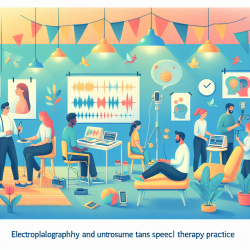Introduction
The study "Dysfunction of attention switching networks in amyotrophic lateral sclerosis" offers significant insights into the cognitive disruptions associated with ALS. This research is pivotal for practitioners in speech-language pathology, particularly those focused on neurodegenerative conditions. By examining the attention switching networks through EEG source analysis, the study provides a data-driven approach to understanding ALS-related cognitive impairments.
Key Findings
The research highlights several critical findings:
- ALS patients exhibit increased power in the left posterior parietal, central, and dorsolateral prefrontal cortices, correlating with impaired cognitive flexibility.
- There is a decrease in the power of dipoles representing activity in the inferior frontal and left superior temporal gyri.
- Source localization of EEG patterns can serve as a non-invasive biomarker for ALS, offering a potential tool for early diagnosis and monitoring.
Implications for Practitioners
For practitioners, these findings underscore the importance of integrating neurophysiological assessments into the therapeutic process. By utilizing EEG and source localization techniques, practitioners can gain a more nuanced understanding of the cognitive deficits in ALS patients. This can lead to more tailored intervention strategies that address specific cognitive impairments, ultimately improving patient outcomes.
Encouraging Further Research
While the study provides a robust framework for understanding cognitive network disruptions in ALS, it also opens avenues for further research. Practitioners are encouraged to explore the application of these findings in clinical settings and consider participating in or initiating studies that further investigate the neurophysiological underpinnings of ALS.
Conclusion
The research on attention switching networks in ALS offers valuable insights that can enhance the practice of speech-language pathologists. By adopting data-driven approaches and integrating advanced neuroimaging techniques, practitioners can better address the complex cognitive challenges faced by ALS patients. To delve deeper into the original research, please follow this link: Dysfunction of attention switching networks in amyotrophic lateral sclerosis.










